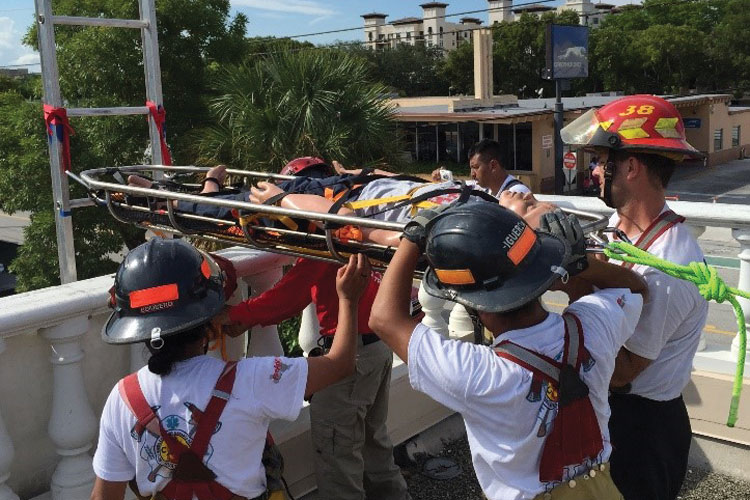
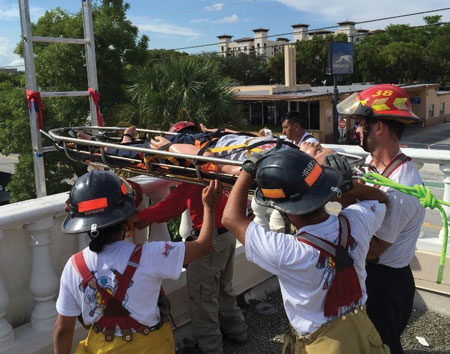 By Jeremy Rifflard
By Jeremy Rifflard
 |
| (1) Students are securing the victim into the rescue basket with a one-inch tubular webbing harness. After the harness, the patient can be secured with another webbing that crosses the patient in an “X” pattern three times. (Photos by author unless otherwise noted.) |
A person with a spinal injury needs to be moved with minimal or no manipulation of the neck or spine. A backboard with a cervical collar and spinal-immobilization device is often the best practice to limit movement of the patient. If there is a small elevator or narrow stairwell, movement of the backboarded patient can be challenging. On certain occasions, a technical rescue team may be called to bring the patient to the ground. Waiting for a technical rescue response may take a great amount of time. Many fire companies have the equipment and ability to execute the ladder pivot rescue; all they need is training.
 |
| (2) The ladder pivot rescue. It is used when removing a patient from a second- or third-story window or the roof. |
To begin rigging a rope rescue system, the patient on the backboard is moved and secured into the rescue basket. The rescue basket creates a more stable platform than the backboard alone. This basket has a rail rescuers can grab during movement. There are areas to connect rigging components; not all rescue baskets are approved for lifting. The general duty-rated basket is an approved lifting device for elevated victim rescue. Technical rescue teams often use the basket as their “go to” device.
 |
| (3) The anchor strap is wrapped around a structural member and connected with a carabiner. |
Nontechnical trained personnel can move the basket when the incident is not a high-angle rescue. The basket has no moving parts and requires minimal training to carry it. Four persons can carry a patient in a basket on flat pathways.
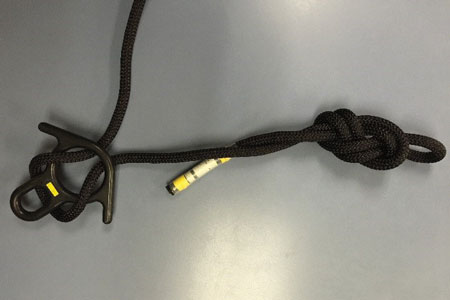 |
| (4) A bight in the rescue rope is pushed through the center of the rescue 8 and over the end of the device before it is attached to the carabiner or the anchor. |
On high-angle rescues, the patient must be secured in the rescue basket to prevent his weight from shifting from side to side. The shifting weight of a patient who reaches out to grab at something can cause the basket to tip. The patient can be secured with a seat belt attachment if the patient is carried on level, stable ground.
 |
| (5-6) A rescue 8 with ears is used as the lowering device, which is attached to the anchor plate with a carabiner. When possible, anchor to a structural member of the building. |
If the patient will be moved across an elevation or a slippery surface, the patient should be secured with a stronger device, such as a one-inch tubular webbing or a manufactured patient tie-in system (photo 1). The webbing can be girth hitched to the foot end of the basket. Typically, a webbing will cross the patient three times in an “X” pattern and be finished with a clove hitch knot with a safety near the head or shoulder area of the basket. The patient may be secured with a webbing harness in addition to the “X” pattern to limit side-to-side weight shifting.

The Ladder Pivot
Before the evolution of the technical rescue team, trained firefighters used a ladder pivot to move a patient from a second- or third-floor window or roof (photo 2). This is a basic technique that requires minimal equipment: rescue basket; a ½-inch static kernmantle rescue rope; a rated anchor rigging strap or similar device; five or more general duty-rated carabiners; two short tubular or flat webbings (about five to six feet in length); a rescue 8 plate or an extra-large offset carabiner as a lowering device; and a ground ladder that will extend just above your departure point.
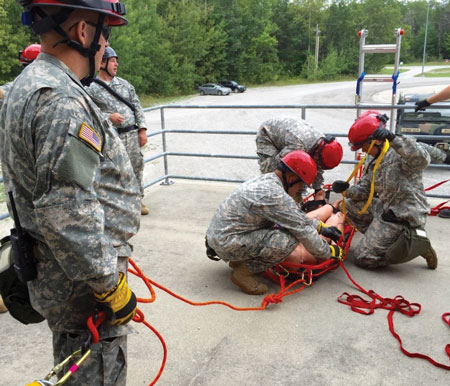 |
| (7) Michigan National Guard rescuers secure the patient into the basket. The anchor is in line with the departure point. |
Survey the structure to find a window or roof that is adjacent to the patient. This will be your departure point. The area below the departure point must be clear of obstructions that would interfere with a raised ladder’s tilting to the ground and of overhead electrical wires. If you have the departure point and a clearing below, a trained group can accomplish a ladder pivot rescue.
 |
| (8) The rope is attached to the head of the basket with a double-loop 8 knot. |
The rescue drill begins with the backboarded mannequin/patient being secured into the stokes basket with a webbing, waist harness, or similar device. With a webbing attachment, connect the backboard and patient to the basket. This will keep the patient inside the basket during movement. There are manufactured webbing and clasp systems to tie the patient into the basket. These systems are very efficient; the patient can be quickly removed when four clasps or buckles are released.
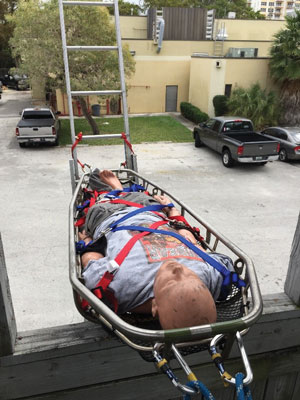 |
| (9) As the ladder is tilted, the basket is moved off the structure. |
Rigging
Anchor the basket system to a sturdy point on the roof or inside the building. Whenever possible, strap the anchor on a structural component of the building. Wrap the anchor strap around the structural component and carabiner the buckles (photo 3). Attached to the anchor strap is a lowering device (descender) such as an 8 plate or a Munter Hitch on an extra-large offset carabiner. If a rescue 8 plate is used, load the rope bight through the center hole of the 8 and over the end before attaching the carabiner to the anchor strap (photo 4). Note: A bar rack is not a desirable lowering device because it adds too much friction.
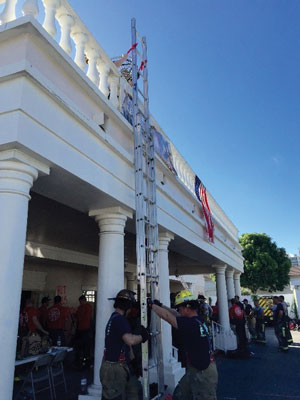 |
| (10) Two or more firefighters place the ladder flush against the building. |
After the anchor is rigged, place the rope in the lowering device and attach the lowering device to the anchor strap with a carabiner (photos 5-6). Tie the end of the rope with a double-loop figure 8 knot with loops about 12 inches in length. Using a carabiner, attach one loop to each side of the head end of the basket (photos 7-8). Tension the rope to remove any slack.
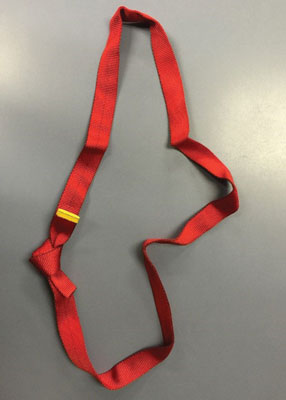 |
| (11) A tubular webbing secured with a water knot. |
Place a ground ladder against the building below the designated departure point. Raise the ladder with three to five rungs higher than the height of the basket’s departure point. Tie the halyard. Using two or more firefighters, place the ladder flush against the building (photo 10). Secure two tubular webbings, each about five feet long, in a loop with a water knot (photo 11). Girth hitch the loops to a rung and beam one or two rungs above the roof or window level on each side of the ground ladder (photos 12-13).
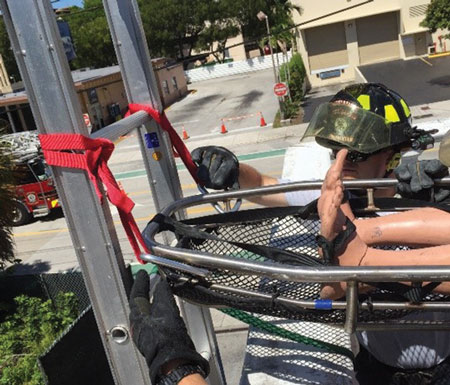 |
| (12-13) On the command of the operations officer, four rescuers raise the basket and move it toward the departure point. Two rescuers near the foot end attach the basket to the webbings on the ground ladder. Do not let the rescue basket sit on the ground, or it will add too much friction until the basket is over the edge. Attach the basket so it is about two feet off the ground. |
One or two firefighters will foot the ladder on the ground. One or two other firefighters will walk down the ladder as a rescuer lowers the rope from the departure point. Additional rescuers may have to pull downward on the ladder to compensate for friction on the lowering device (photo 14). The ladder and patient are lowered to the ground (photo 15). If the webbings attached to the ladder are short, the basket will slightly head up instead of move evenly. The basket will not lie flat on the ladder when it reaches the ground. This may make it difficult to remove the patient from the basket. The preferred length of the two pieces of webbing attached to the ladder is between six and 10 feet.

Guy Ropes
If the basket is coming out of a third-story window or from the roof, guy ropes may be needed for side stability (photo 16). The higher the ladder, the higher the center of gravity. If the 35-foot ladder is used for this drill, attach guy ropes: While the ladder is on the ground, place one guy rope on each side of the raised ladder tip. One person should hold each rope as the ladder is raised. When the ladder is being lowered, guy ropes can be used to apply downward pressure to facilitate a level lowering of the patient.
 |
| (14) A rescuer walks the basket to the ground as the rope lowers it. |
Do not attempt a ladder pivot unless you have been trained on this technique. Practice is needed in using an 8-plate lowering device to tie secure fire service knots and stokes basket packaging skills. With repetition, engine, ladder, and rescue companies can execute a second-story rescue with a ladder pivot.
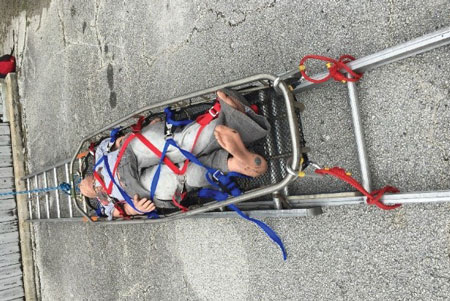 |
| (15) The patient and the basket are on the ground. |
JEREMY RIFFLARD has been a Florida firefighter since 1991. He is a captain with the Fort Lauderdale (FL) Fire Department. He is a rescue squad officer for the FEMA Urban Search and Rescue team, FL-TF2. His most recent task force deployments were to the Haitian Earthquake and Hurricane Ike. He is the lead instructor in structural collapse technician programs for the Coral Springs Regional Institute of Public Safety. For the past 15 years, he has been an instructor and subject matter expert for military urban search and rescue exercises through ATEC Incorporated in Jupiter, Florida.
 |
| (16) Fort Lauderdale (FL) firefighters use a ladder pivot to remove a patient having seizures off a roof. (Photo by John McLoughlin.) |
Throw Back to Basics: Stokes Basket|
Drills You Won’t Find in the Books: Stokes Snow Sled Drill
Drills You Won’t Find in the Books: Bangor Ladder Rescue for H-Shaped Buildings
Fire Engineering Archives

